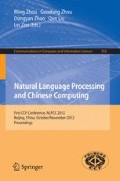Abstract
Prior knowledge of Chinese calligraphy is modeled in this paper, and the hierarchical relationship of strokes and radicals is represented by a novel five layer framework. Calligraphist’s unique calligraphy skill is analyzed and his particular strokes, radicals and layout patterns provide raw element for the proposed five layers. The criteria of visual aesthetics based on Marr’s vision assumption are built for the proposed algorithm of automatic generation of Chinese character. The Bayesian statistics is introduced to characterize the character generation process as a Bayesian dynamic model, in which, parameters to translate, rotate and scale strokes, radicals are controlled by the state equation, as well as the proposed visual aesthetics is employed by the measurement equation. Experimental results show the automatically generated characters have almost the same visual acceptance compared to calligraphist’s artwork.
Access this chapter
Tax calculation will be finalised at checkout
Purchases are for personal use only
Preview
Unable to display preview. Download preview PDF.
References
Bai, B., Wong, K.-W., Zhang, Y.: An Efficient Physically-Based Model for Chinese Brush. Frontiers in Algorithmics, 261–270 (2007)
Bai, B., Wong, K.-W., Zhang, Y.: A Virtual Chinese Hairy Brush Model for E-Learning. In: Leung, H., Li, F., Lau, R., Li, Q. (eds.) ICWL 2007. LNCS, vol. 4823, pp. 320–330. Springer, Heidelberg (2008)
Yang, L., Li, X.: Animating the Brush-Writing Process of Chinese Calligraphy Characters. In: Eighth IEEE/ACIS International Conference on Computer and Information Science (ICIS 2009), pp. 683–688 (2009)
Xu, S., Jiang, H., Jin, T., Lau, F.C.M., Pan, Y.: Automatic Facsimile of Chinese Calligraphic Writings. Computer Graphics Forum 27(7), 1879–1886 (2008)
Xu, S., Jiang, H., Jin, T., Lau, F.C.M., Pan, Y.: Automatic Generation of Chinese Calligraphic Writings with Style Imitation. IEEE Intelligent Systems 24(2), 44–53 (2009)
Zhu, X., Jin, L.: Calligraphic Beautification of Handwritten Chinese Characters: A Patternized Approach to Handwriting Transfiguration. In: International Conference on Frontier on Handwriting Recognition, ICFHR 2008 (2008)
Mi, X.-F., Tang, M., Dong, J.-X.: Droplet: A Virtual Brush Model to Simulate Chinese Calligraphy and Painting. Journal of Computer Science and Technology 19(3), 393–404 (2004)
Founder Electronics Co. Ltd., http://www.foundertype.com/
Dynacomware Co. Ltd., http://www.dynacw.cn/
Beijing Hanyi Keyin Information Technology Co. Ltd., http://www.hanyi.com.cn/
China Great Wall Computer Group Co., Ltd., http://www.greatwall.com.cn/
Wong, S.T.S., Leung, H., Ip, H.H.S.: Brush Writing Style Classification from Individual Chinese Characters. In: 18th International Conference on Pattern Recognition (ICPR 2006), pp. 884–887 (2006)
Chang, W.-D., Shin, J.: Interactive Virtual Oriental Brush with Pen-Tablet System. Knowledge-Based Intelligent Information and Engineering Systems, 387–394 (2007)
Mi, X., Xu, J., Tang, M., Dong, J.: The Droplet Virtual Brush for Chinese Calligraphic Character Modeling. In: Sixth IEEE Workshop on Applications of Computer Vision (WACV 2002), pp. 330–334 (2002)
Xu, S., Jiang, H., Lau, F.C.M., Pan, Y.: An Intelligent System for Chinese Calligraphy. In: Proceedings of the 22nd National Conference on Artificial Intelligence, Vancouver, British Columbia, Canada, vol. 2, pp. 1578–1583 (2007)
Yao, F., Shao, G., Yi, J.: Extracting the Trajectory of Writing Brush in Chinese Character Calligraphy. Engineering Applications of Artificial Intelligence 17(6), 631–644 (2004)
Lai, P.-K., Pong, M.-C., Yeung, D.-Y.: Chinese Glyph Generation Using Character Composition and Beauty Evaluation Metrics. In: International Conference on Computer Processing of Oriental Languages (ICCPOL), Honolulu, Hawaii, pp. 92–99 (1995)
Lai, P.-K., Yeung, D.-Y., Pong, M.-C.: A Heuristic Search Approach to Chinese Glyph Generation Using Hierarchical Character Composition. Computer Processing of Oriental Languages 10(3), 281–297 (1997)
Yu, K., Wu, J., Zhuang, Y.: Skeleton-Based Recognition of Chinese Calligraphic Character Image. In: Huang, Y.-M.R., Xu, C., Cheng, K.-S., Yang, J.-F.K., Swamy, M.N.S., Li, S., Ding, J.-W. (eds.) PCM 2008. LNCS, vol. 5353, pp. 228–237. Springer, Heidelberg (2008)
Zhuang, Y., Lu, W., Wu, J.: Latent Style Model: Discovering Writing Styles for Calligraphy Works. Journal of Visual Communication and Image Representation 20(2), 84–96 (2009)
Xu, L., Ding, X., Peng, L., Li, X.: An Improved Method Based on Weighted Grid Micro-Structure Feature for Text-Independent Writer Recognition. In: 2011 International Conference on Document Analysis and Recognition (ICDAR 2011), pp. 638–642 (2011)
Marr, D.: Vision: A Computational Investigation into the Human Representation and Processing of Visual Information. W.H. Freeman and Company, New York (1982)
West, M., Harrison, J.: Bayesian Forecasting and Dynamic Models. Springer, New York (1997)
Carpenter, J., Clifford, P., Fearnhead, P.: Improved Particle Filter for Nonlinear Problems. IEE Proceedings on Radar, Sonar and Navigation 146(1), 2–7 (1999)
Doucet, A., Godsill, S., Andrieu, C.: On Sequential Monte Carlo Sampling Methods for Bayesian Filtering. Statistics and Computing 10(3), 197–208 (2000)
Carlin, B.P., Polson, N.G., Stoffer, D.S.: A Monte Carlo Approach to Nonnormal and Nonlinear Statespace Modelling. Journal of the American Statistical Association 87(418), 493–500 (1992)
Gordon, N.J., Salmond, D.J., Smith, A.F.M.: Novel Approach to Nonlinear/Non-Gaussian Bayesian State Estimation. IEE Proceedings-F, Radar and Signal Processing 140(2), 107–113 (1993)
Author information
Authors and Affiliations
Editor information
Editors and Affiliations
Rights and permissions
Copyright information
© 2012 Springer-Verlag Berlin Heidelberg
About this paper
Cite this paper
Shi, C., Xiao, J., Jia, W., Xu, C. (2012). Automatic Generation of Chinese Character Based on Human Vision and Prior Knowledge of Calligraphy. In: Zhou, M., Zhou, G., Zhao, D., Liu, Q., Zou, L. (eds) Natural Language Processing and Chinese Computing. NLPCC 2012. Communications in Computer and Information Science, vol 333. Springer, Berlin, Heidelberg. https://doi.org/10.1007/978-3-642-34456-5_3
Download citation
DOI: https://doi.org/10.1007/978-3-642-34456-5_3
Publisher Name: Springer, Berlin, Heidelberg
Print ISBN: 978-3-642-34455-8
Online ISBN: 978-3-642-34456-5
eBook Packages: Computer ScienceComputer Science (R0)

